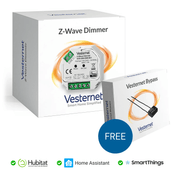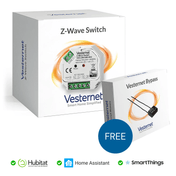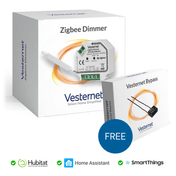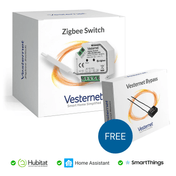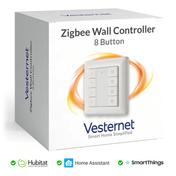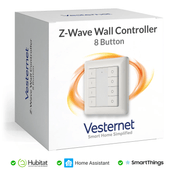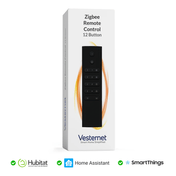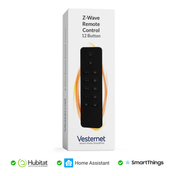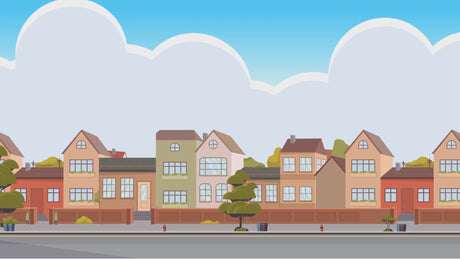
Z-Wave, Zigbee & WiFi Heating Controls cover a vast array of devices from many different categories - sensors, thermostats, TRVs, actuators, etc, etc.
Manufacturers of Z-Wave, Zigbee & WiFi Heating Controls have different types available designed to do specific roles, this gives you the best product for the job, but can make choosing the right device a little more difficult. You also have the choice between manufacturers to contend with, where some will offer more advanced capabilities and others will offer simpler functionality, often at a cheaper price. Remember that you can mix and match manufacturers on the same system as they are all compatible - more information can be found in our Understanding Compatibility guide.
This guide explains what the different types of device are used for and gives extra details to help select between the manufacturers.
Heating Controls
Adding Smart Control to Heating Systems in order to create a Smart Home Heating System can be complex as it not only depends on what you’re trying to achieve but also on what type of heating system it is (electric, water based, UFH, forced air, etc) and how the heating system was designed in terms of piping, valves, motors, pumps and existing control systems.
If you already have a Smart Home system in place or are planning to implement one for Lighting or Security, then it makes sense to integrate heating control too as this makes for a nice consolidated system.
No matter what the system type is, broadly speaking, Heating Controls are split into several areas - Thermostas, Thermostatic Radiator Valves, Heat Source Controls and Ancillary Components such as temperature & humidity sensors.
Thermostats - Z-Wave | Zigbee | WiFi
Thermostats are typically used as a reference device to both monitor the room's ambient temperature and to allow manual entry of a setpoint temperature that the room should be kept at.
In a simple system you might only have a single thermostat that directly manages a Heat Source Control, so that the heat source is turned on when the temperature reported by the thermostat is lower than the setpoint input on the thermostat.
In a more complex system there might be many thermostats throughout the home, with each one reporting whether the room that it is located in requires heat or not. In this scenario the Smart Home Controller is typically used to arbitrate these heat demands, amalgamating them together to produce an overall heat demand for the home and then managing the Heat Source Control in response.
Thermostats - things to think about:
- Physical Installation - Some Thermostats are battery powered and are easy to install, simply site them anywhere - stick them to a wall or sit them on a shelf or sideboard. Others need permanent power and require wiring to the AC main supply so you might need the services of an electrician to connect them up.
- KISS - Keep It Simple Stupid - As with many aspects of the Smart Home, simpler is often better. It might be cool to have Thermostats with multiple features such as motion sensing, humidity sensing, schedules, smart heating algorithms, etc, etc, but ultimately if you're implementing a multi-zoned system where the Smart Home Controller is going to be responsible for managing all the logic then a simpler device might suffice. If all you need is something to monitor the room temperature and allow manually control of the setpoint then a Thermostat with just those features will work out much cheaper, perhaps an important consideration if you need one for every room!
- Temperature Reading - Some Thermostats report the local temperature back to the Smart Home Controller. While this isn't strictly required, it can be useful in order for the Smart Home Controller to know whether the local temperature has reached the chosen setpoint.
- Heat Demand - In a multi-zone heating system you will be responsible for creating the logic to control the system yourself in your Smart Home Controller. An important aspect of this is controlling the "heat demand" correctly - it must only supply heat (i.e. be running) when one of the heating zones requires heat, otherwise it might be damaged. For example a boiler might fail if it's trying to heat the water in the system and pump it around the system if there's no open zones! It can be useful therefore for your chosen Thermostat to report its own heat demand i.e. when its temperature is lower than its required setpoint.
- Schedules - In most cases you'll control the Thermostat directly from the Smart Home Controller, changing the setpoint to suit your required comfort levels, perhaps based on occupancy of the rooms. On the other hand, it can be useful for the Thermostat to have some built in scheduling capabilities as this will allow it to run autonomously based on the schedule that's been set, rather than needing to be controlled by the Smart Home Controller.
- Radio Availability - When a Thermostat is battery powered, it will spend most of its time with its Z-Wave / Zigbee / WiFi radio asleep in order to conserve power. Some devices will only periodically "wake up", for example every 5 minutes, in order to check in with the Smart Home Controller and receive any pending instructions to change the setpoint or update any schedules. Other devices are what's classed as "frequently listening" so will react much quicker, albeit at the expense of slightly shorter battery life.
- Local Heat Source Control - Some Thermostats are designed with a Heat Source Control built in, they are typically used in a wired system where each room is wired back to a central location, for example a valve manifold system. Each Thermostat is then responsible for managing the room that it's in directly, it will track the temperature against the setpoint and operate its own output accordingly. Back at the manifold the Thermostat output will typically control a valve to allow water to flow, perhaps to radiators or through the under floor heating (UFH) pipework.
- Information - More information about these issues and other things to consider is available in our Smart Home Heating guide.
Thermostatic Radiator Valves (TRVs) - Z-Wave | Zigbee | WiFi
In a water based heating system, Thermostatic Radiator Valves (TRVs) control when hot water is allowed to flow into a radiator based on the TRV's setpoint temperature. When the ambient temperature is lower then the setpoint, the radiator valve is "Open" and water flows through the radiator. When the setpoint is reached, the valve closes, stopping the water flow and allowing the radiator to cool.
Some TRVs have complex algorithms that regulate how quickly the temperature changes, this reduces the chance of over-shooting the setpoint and wasting heat. Some TRVs also report the actual ambient temperature to the system, these can be used in place of a wall thermostat, but the temperature readings may not be very accurate as they are positioned very close to the hot radiator!
Thermostatic Radiator Valves (TRVs) - things to think about:
- Physical Installation - If you already have TRVs on your radiators then this will be as simple as swapping over the "head" i.e. removing the existing manual control head and replacing it with your chosen Smart device. On the other hand, if you don't already have TRVs fitted then you'll need to have that carried out first, likely by a plumber since the heating system will need to be drained down so that the existing valves can be changed.
- Temperature Reading - Some TRVs report the local temperature back to the Smart Home Controller. While this isn't strictly required, it can be useful in order for the Smart Home Controller to know whether the local temperature has reached the chosen setpoint.
- Heat Demand - In a multi-zone heating system you will be responsible for creating the logic to control the system yourself in your Smart Home Controller. An important aspect of this is controlling the "heat demand" correctly - it must only supply heat (i.e. be running) when one of the heating zones requires heat, otherwise it might be damaged. For example a boiler might fail if it's trying to heat the water in the system and pump it around the system if there's no open zones! It can be useful therefore for your chosen TRV to report its own heat demand i.e. when its temperature is lower than its required setpoint and it is "open".
- Schedules - In most cases you'll control the TRVs directly from the Smart Home Controller, changing the setpoint to suit your required comfort levels, perhaps based on occupancy of the rooms. On the other hand it can be useful for the TRV to have some built in scheduling capabilities as this will allow it to run autonomously based on the schedule that's been set, rather than needing to be controlled by the Smart Home Controller.
- Radio Availability - Since TRVs are typically battery powered devices they will spend most of their time with their Z-Wave / Zigbee / WiFi radio asleep in order to conserve power. Some devices will only periodically "wake up", for example every 5 minutes, in order to check in with the Smart Home Controller and receive any pending instructions to change the setpoint or update any schedules. Other devices are what's classed as "frequently listening" so will react much quicker, albeit at the expense of slightly shorter battery life.
- Separate Thermostat - While a TRV will work standalone to manage the water flowing to your radiator based on its own temperature sensor and setpoint temperature, most rooms benefit from a separate Thermostat sited closer to where people in the room will most likely be located, for example on the sofa or in bed. A separate Thermostat allows the system to then control the TRV based on the temperature reading and setpoint from that device, rather than the TRV which is likely not positioned in an optimal location.
- Mounting Position - Make sure that the TRV is capable of being mounted to your radiator valve, some valves require the TRV to be mounted horizontally, some require them to be mounted vertically. This can impact the temperature sensor accuracy, local control operation and the ability to read any local display.
- Information - More information about these issues and other things to consider is available in our Smart Home Heating guide.
Heat Source Controls - Z-Wave | Zigbee | WiFi
Heat Source Controls typically replace your existing heating controller / timer and allow your Smart Home system to control when the heat source (typically a boiler) is On or Off. Usually this is in response to a "Heat Demand", so for example if several rooms in your home require heat (the temperature is lower than the setpoint) then the Heat Source Control will turn on in order for those rooms to be heated. Or, if the hot water tank temperature is low the the Heat Source Control ontrol will turn on in order for the tank to be heated.
With electric based heating, your "heat source" isn't usually a central system like with water based heating, it's typically per room using a heat mat, hot air blower or an electic panel heater. In these cases the "Heat Source Control" can be as simple as a plug-in socket!
Heat Source Controls - things to think about:
- Heat Source Control Type - It's important to match the Heat Source Control to the type of heat source that you have, for example if you have a Combi boiler, you will need a single-channel Heat Source Control, if you have a Y-plan or S-plan system boiler then you will probably need a 2-channel Heat Source Control, one for the radiator system and one for the hot water system.
- It's just a switch? - Dedicated Heat Source Controls will offer things like local control override switches, status LEDs, etc. But ultimately their only job is to "switch" an input into your heat source, so in many cases a simpler device such as a Z-Wave, Zigbee or WiFi module will do the same job.
- Switched Live / Dry Contact - Some heat sources will require a simple Switched Live input signal whereas others will require a dry-contact input signal, so make sure to choose the right control device.
- Multiple Channels - Your heat source might just need a single input, to indicate that the radiator system needs heat, or it might need two inputs, one for the radiator system and one for the hot water system. Sometimes the heating system will be very complicated, using multiple different "zones" that each require an individual heat demand input. In these types of system it's common to use a Heat Source Control that has many outputs so that it can control all of the separate heat demand inputs on the system.
- Electric is Simple - As mentioned above, for electric based heating you'll typically be controlling a single heat source per room directly, so in these cases you'll need to make sure your chosen device is suitably rated. For example an electric panel heater might be rated at 2kW so you'd need to make sure the device is rated for that - we usually recommend leaving some headroom so that you're not running the device at its maximum rating for prolonged periods.
- Information - More information about these issues and other things to consider is available in our Smart Home Heating guide.
Ancillary Components - Z-Wave | Zigbee
Ancillary Components cover many types of devices and are typically dependant on what type of heating system you are attempting to add Smart control to and of course what you are trying to achieve.
Ancillary Components - things to think about:
- Temperature & Humidity Sensors - These work well as part of a multi-zoned heating system - by allowing your Smart Home Controller to monitor the temperature of individual rooms and zones you can maximise the efficiency of your radiators. They can also be used in a wider context of environmental control, for example monitoring tanks and pipes to ensure your boiler is operating efficiently or to create graphs and reports of monitored temperatures in order to learn how your home reacts to heat and cold.
- Motion Sensors - These can allow your Smart Home Controller to adapt the heating logic based on occupancy of rooms, perhaps turning off the radiators in rooms that aren't in use.
- Contact Sensors - Optimising your heating system is often the best way of savng money on your energy bills, Contact Sensors allow your Smart Home Controller to lower the setpoint in areas where doors and windows have been left open to avoid wasting heat!
- Information - More information about these issues and other things to consider is available in our Smart Home Heating guide.
Getting Help and Advice
Hopefully this guide has helped clarify what options are available, what the different Z-Wave, Zigbee & WiFi Heating Controls do, and shown the comparison between manufacturers. If you need any further help or advice, contact Vesternet and we will do our best to answer all your questions.









